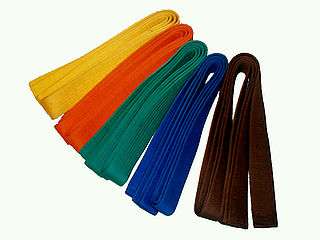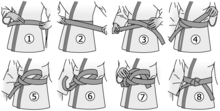Obi (martial arts)


Many Japanese martial arts feature an obi as part of their exercise outfit. These obis are often made of thick cotton and are about 5 cm wide. The martial arts obis are most often worn in the koma-musubi knot (square knot); in practice where hakama is worn, the obi is tied in other ways.
In many martial arts the colour of the obi signifies the wearer's skill level. Usually the colours start from the beginner's white and end in the master's black, or red and white.
Aikido
Unlike in many other martial arts, adult practitioners of aikido do not wear coloured obis,[1] though in some schools different colour codes have been formed,[1] especially for children. The children's obis range from white for beginner level to 5th kyū, other colours for the rest of the kyū levels, and black for levels 1st dan and up.[2]
In some aikido schools, wearing a hakama is a privilege earned by reaching the first dan level. In other schools, all practitioners may wear a hakama. After taking up using a hakama, the colour of obi does not matter since it will be covered by the hakama.[2]
Example of colour range in aikido
Below is a typical example of obi colours per level in aikido:[1]
| Level | Obi colour |
|---|---|
| 6th kyū | yellow |
| 5th kyū | orange |
| 4th kyū | green |
| 3rd kyū | blue |
| 2nd and 1st kyū | brown |
| 1st-3rd dan | black |
| 4th-9th dan | black and red, or white and red |
| 10th dan | red |
However, aikido schools worldwide may use their own systems with little reference to other schools save the use of a black belt for at least some dan grades.
Atarashii naginata
The outfit used for Atarashii naginata practice includes a hakama that covers the obi. The obi is always white; its colour has no significance beyond simply blending in with the white keikogi worn when practicing the art.
Iaido
The outfit worn to iaido practise includes a hakama, which is worn over the top of the obi, which fastens the keikogi. The obi colour has no meaning in iaido,[3] and is usually chosen to blend in with the kimono or hakama worn by the practitioner.
Jōdō
The outfit used for jōdō practise includes a hakama that covers the obi. The colour of the obi has no significance.
Judo
Below are the colours of obis worn for judo practise. Junior practitioners have a different colour range.[4] There are also other colour ranges used worldwide.
| Judoka Level | Obi colour |
|---|---|
| Beginners | White |
| 5th kyū | Yellow |
| 4th kyū | Orange |
| 3rd kyū | Green |
| 2nd kyū | Blue |
| 1st kyū | Brown |
| 1st - 5th dan | Black |
| 6th and 9th dan | Red and White |
| 10th dan | Red |
Jujutsu
The colours for obis used for jujutsu practise range as follows:[5]
| Level | Obi colour |
|---|---|
| beginners | red |
| 10th – 8th kyū | red |
| 7th kyū | white with a red stripe |
| 6th kyū | yellow |
| 5th kyū | orange |
| 4th kyū | green |
| 3rd kyū | blue |
| 2nd kyū | violet |
| 1st kyū | brown |
| Shōdan-ho | brown and black ("temporary black") |
| 1st - 5th dan | black |
| 6th dan and higher | red and white |
Jūkendō
The outfit used for Jūkendō practise includes a hakama that covers the obi. The colour of the obi has no significance.
Karate
Wado-ryuThe obis used in the wado-ryu style range in colour as follows:[6]
ShotokanThe obis used in the shotokan style range in colour as follows:[7]
Shito-RyuThe obis used in the Shito-Ryu style range in colour as follows:[8]
|
Kendo
The outfit used for kendo practise includes a hakama that covers the kendogi. An obi is optional; if worn, its colour has no significance.[9]
Kyūdō
The outfit used for kyūdō practise includes a hakama that covers the obi. The colour of the obi has no significance.
T'ai Chi Ch'uan
The outfit used for T'ai Chi is either loose-fitting, comfortable clothing or the same kind of uniform as Kung Fu. Some schools also include coloured sash, but no standard for their order has been established. They commonly follow the same basic rules as Kung Fu, beginning with white, yellow, orange, purple, blue, green, brown and black. Some may skip a rank, others may subdivide them with a stripe or tag.
References
- Bennett, Gary (1997). Aikido techniques & tactics. Human Kinetics Publisher. ISBN 0-88011-598-X.
- Goodman, Fay (1998). The Ultimate Book of Martial Arts. Lorenz Books. ISBN 1-85967-778-9.
Notes
- 1 2 3 Bennett p. 8-11
- 1 2 Goodman s. 70
- ↑ Goodman p. 230-231
- ↑ Goodman s. 134
- ↑ Goodman s. 101
- ↑ Goodman s. 32
- ↑ Goodman s. 52
- ↑ http://shitokai.com/cyber-academy/shitoryu-karate-do-grading-syllabuses
- ↑ Goodman s. 214. This was mentioned in Sword Art Online when Kirito and his sister fought using Kendo.
